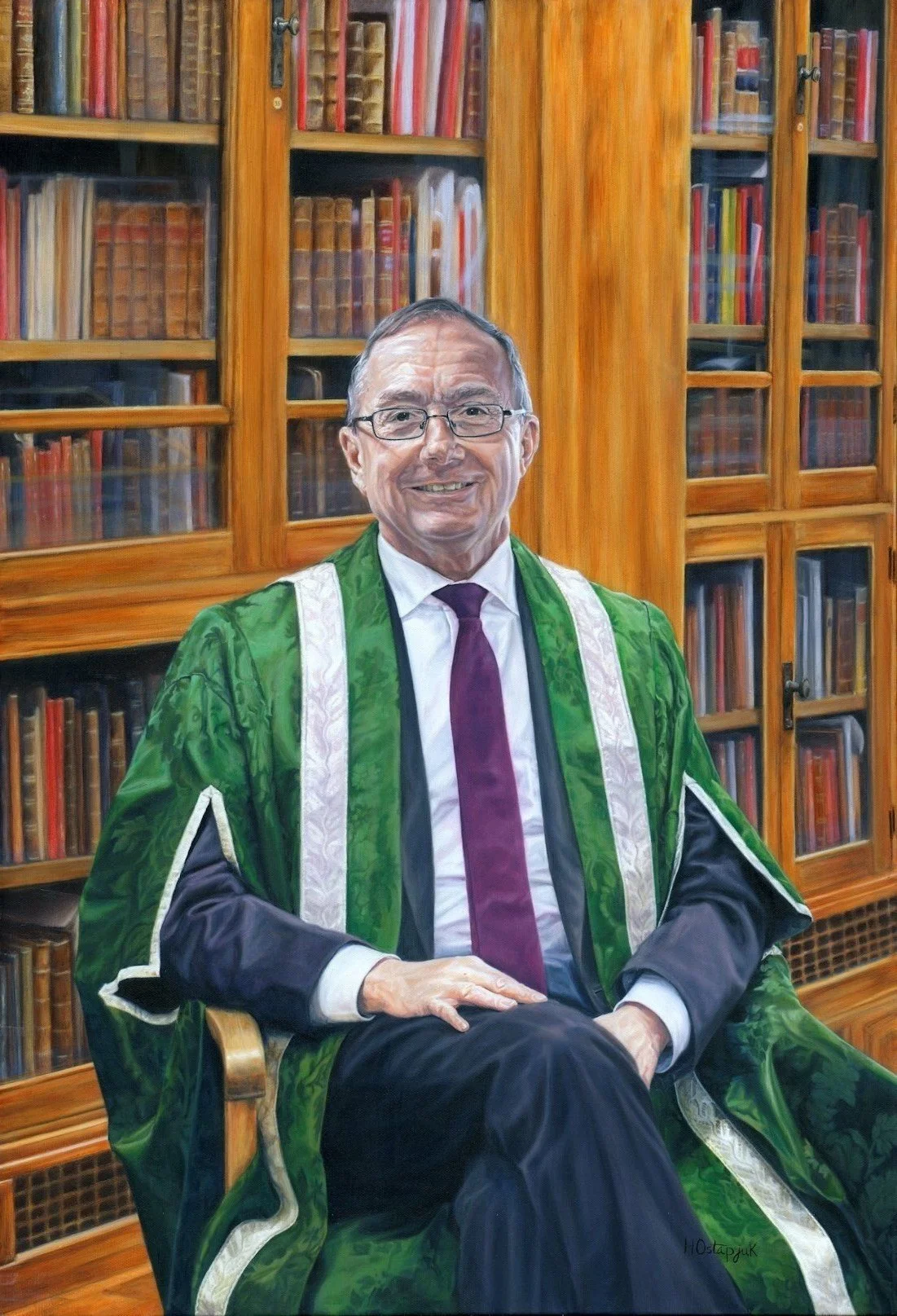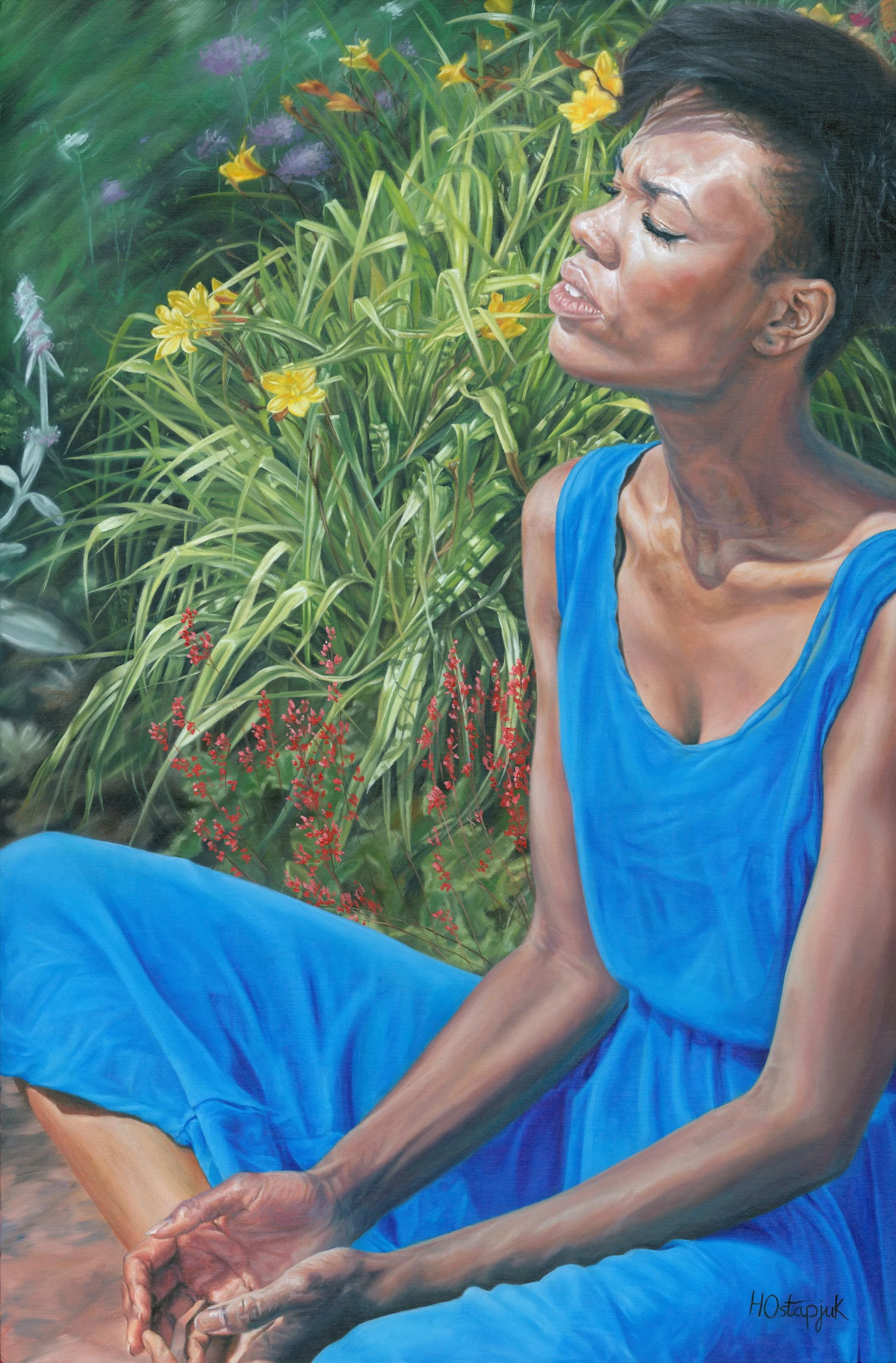ARTIST INTERVIEW: Hannah Ostapjuk
Hannah Ostapjuk
Can you describe the moment when you decided you wanted to pursue art as a career?
A very wise and kindly gentleman turned to me and said, "Why are you not doing art?". That gentleman was Dr David Hudson, then Headteacher of my secondary school. I'd just unveiled his portrait and on hearing his words suddenly realised that I'd been blind to my own talents and capabilities. On the Friday before I started University, that following Monday, I switched my specialism to Contemporary Art and I've never looked back.
What initially drew you to portraiture? Why are you so fascinated by the human form?
This is a funny one because I began my art journey doing everything possible to avoid drawing or painting the human form - because that's what school wanted me to draw and paint. Top marks were only awarded to those who painted portraits or drew figuratively - so I insisted on gaining top marks through drawing animals, not humans.
Gaining my first commission drew me to portraiture and I became fascinated with the human form, initially through the study of anatomy within biology and sports science. I developed a real love of the greats, Old Masters such as: Rembrandt, Caravaggio, Rubens, Michelangelo. Now, for me, the body is beautiful, we're all so unique and I see that beauty - so easily - and I want to show you (because we often don't see it for ourselves).
Beautiful Mind
In your biography you state that 'portraiture is not just about investigating appearances or recreating what you see... it is about painting what I feel.' How do you connect with your sitters? Why is the relationship between yourself and the sitter so important in your practice?
First five minutes with someone, I've got them down. Obviously while it's preferable to spend as much time as possible with my sitters, this can be anything from 20 minutes to several sittings, that first impression (first 5 mins) is key. I want to know what makes them tick, lots of chatting involved, lots of observation - that sounds creepy to the non-artist but I absorb so very much and very easily that the 'observation' is not noticeable.
That relationship is the portrait and it is a big part of what makes up my fuel to create.
Susan Price
At just 17 years old you were commissioned to paint a portrait, and have since gone on to appear in both public and private collections across the UK. How did you feel painting that first commission? Are you still happy with the piece now, or would you change your approach at all?
I was grateful and surprised to be chosen, it was exciting but daunting - I didn't have an easel or professional brushes. When the nerves wore off, I took that portrait and the opportunity and I threw myself into it - all in. I don't do things by halves.
I am still very happy with that piece now because it represents so much: a realisation, an action, a change in the course of my life, it's of a man who is sadly no longer with us and even though my skills or techniques may have advanced or slightly changed, people still to this day, 19 years later, tell me how much they see of Dr Hudson in that portrait, how it truly captures him. I'm very proud of that portrait.
Thinking about your most recent piece, what sparked your imagination to create it? Describe your process from start to finish.
Now this is an oil painting that's not yet complete*, it's part of an ongoing series of two little girls enjoying the English countryside. I'd been collecting material, photos, sketches, etc for years but that first summer out of lockdown (July 2021), a walk with a friend and her daughter coupled with enjoying the simpler things in life, sparked my imagination and initiated the process to actually start the paintings.
Over a few pencil guidelines, I apply a warm ground (a mix of burnt umber and burnt sienna) and complete an underpainting of the scene and figures: working up the darks and wiping away the highlights. Then I come in with colour. I paint in layers, using glazes. Darks, I try to keep clean and thin and I build up the brights and colour more impasto - depending on where I want to direct the viewers' gaze. The countryside scene is inspired by the work of artist John Constable, so I've books open on the floor as I paint to make sure my hand is influenced by what I can see around me. The figures I'm painting in more of an oil sketch style, this is influenced by both the old masters and very current artists of today.
To see the 'finish' you'll have to follow me.
*The progress of this piece so far can be viewed on my social media channels: Instagram, Facebook, YouTube, etc.
Which facial feature is your favourite to paint? Which feature do you find most challenging?
Eyes, I think eyes, it's tough to choose because I get a kick out of painting ears or noses sometimes. Let's stick with eyes as my current favourite.
Depends on the portrait in hand, I think the colour of lips can sometimes be an interesting one - lips are almost too simple so in that there's a lot you can get wrong if you're not careful. Yet I love lips. Can I say that each can be my favourite and a challenge all at the same time? I think I love the challenge.
Your sitters include the likes of Professor Susan Price CBE & Sir Michael Arthur. Out of all your sitters, who has been your favourite to paint, and why?
You're going to love me again here, there's a theme of not being able to choose developing...
One that instantly comes to mind is the late Colonel Edward York, then Vice Lord Lieutenant of North Yorkshire, because he was such a joy to work with and the love between him and his wife, Sarah, it was just so special to see that and be in their presence. Her reaction to his portrait I'll never forget because she said how handsome he looked. Colonel York was very tall and originally wanted a tiny head and shoulders portrait, eventually I steered it towards a larger half-length and included a nod to the portraits of his Great and Great Great Grandfathers. The whole process start to finish was something you could really get into: spending time with Sarah and Edward, collecting all the material, the portrait so intune with where I was in my career (in terms of: style, techniques, subject) and so much fun to paint, and that reaction in the end - an absolute gem.
Colonel Edward York
Sir Michael Arthur, then Professor Michael Arthur previous Vice Chancellor, had one of the best reactions I've ever had to a portrait, racing across the Great Hall, at The University of Leeds, as his portrait was unveiled to a very large room of people (it was a huge event) to throw his arms around me.
Professor Michael Arthur
However, over the past year I've worked with a few of the most incredible people, portraits that are yet to be unveiled, these are definitely right up there level with Colonel York in the top favourites and one painting in particular I'm so proud of, it's a masterpiece.
I think what makes a favourite for me is first and foremost, the people I'm working with: my sitter or the person commissioning the painting, as this makes the process fun. Second, it's the reaction to the portrait in the end. That relationship and that reaction on unveiling really fuels my fire.
What would your dream commission entail?
Painting royalty, I adore the royal family, or painting someone I really respect and champion - I've a whole list and I'll get there. Of course it'd have to be the full package of: an amazing sitter, fun process, a challenging and rewarding piece to paint - lots to get my teeth into, and that reaction on unveiling would have to be epic.
Why do you think art is important in society?
What did so many turn to when there was a pandemic - the arts and art in particular. Without art you've got nothing. Art keeps creativity alive and a creative flair is needed in many, if not all, fields to be successful. Art heals, it's therapy, I use it like that myself and I've seen it with my own eyes - how it can help. Art connects us, challenges us, and helps us make sense of the world around us. It helps us grow as individuals and communities. The world stops turning when art is no more.










